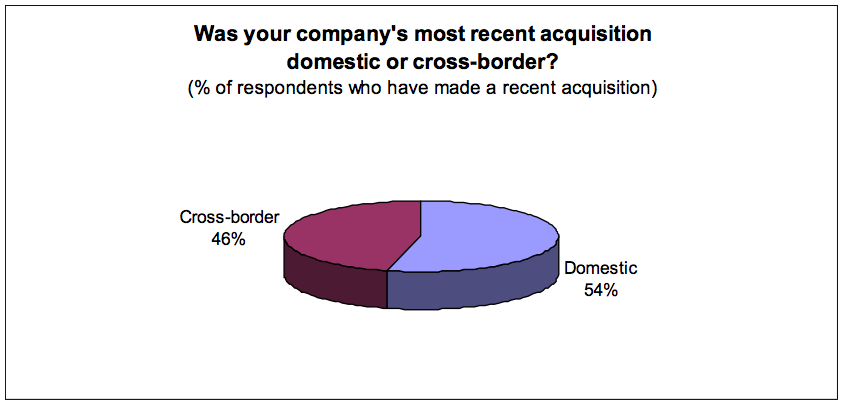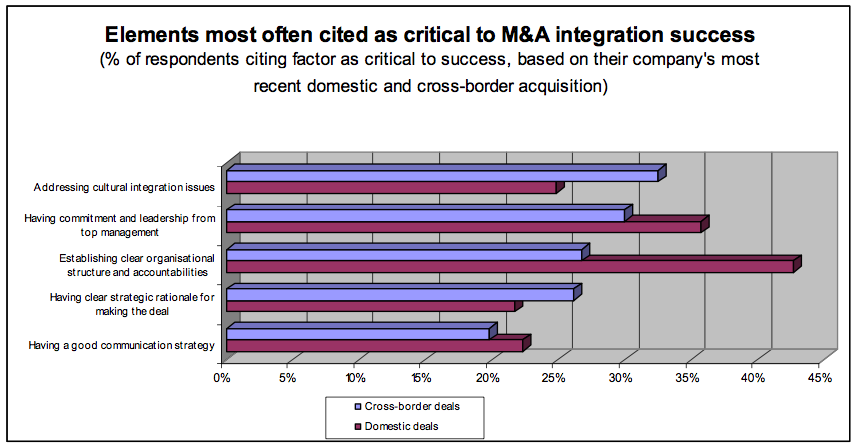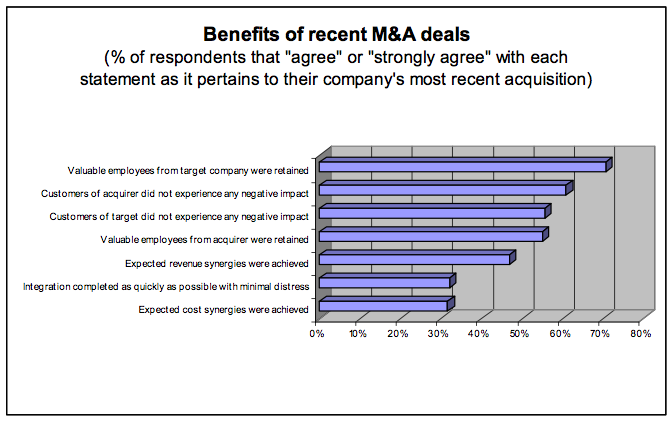
Publications Mergers And Acquisitions — Experiences Of Indian Executives
- Publications
Mergers And Acquisitions — Experiences Of Indian Executives
- Bea

SHARE:
By Accenture
In the first half of 2006, Accenture and the Economist Intelligence Unit surveyed senior executives in North America, Europe and Asia on their mergers and acquisitions (M&A) activity and their experiences in integrating companies. In the fourth quarter of 2006, the same survey was administered to 156 executives based in India.
Of the total respondents in India, 40% were senior-level. About 64% were from companies that had global annual revenues of US$100m or more and 36% had revenues of US$1bn or more. The executives mainly played roles in strategy and business development (45%) and general management (42%). Their companies were from a wide range of industries, including financial services (25%), IT and technology (21%) and professional services (13%).
The following are among the key findings of the survey and comparisons with the North America/Europe (US, UK, Germany, Sweden, Norway and Finland) and Asia (China and Japan) results.
• M&A is becoming more important as a growth strategy. When asked to estimate the percentage of their company’s total global revenue growth that has come from M&As in the last three years, only a quarter of respondents said that it was 20% or more. But when asked to forecast what would happen in the next three years, 57% of respondents said that this amount of growth would come from M&As.
• Most recent acquisitions were domestic — but cross-border deals will be essential. About 74% of the respondents had made an acquisition, and of these, 54% reported that the most recently acquired company was domestic. In fact, 67% agreed that they find cross-border acquisitions generally more difficult than acquisitions in the domestic market. Far more domestic deals were conducted by Chinese (98% of respondents) and Japanese (84%) companies recently. In contrast, companies surveyed from North America and Europe conducted more cross-border acquisitions (58% of those who conducted M&As) recently.
Nevertheless, respondents from India said that companies in their industry will be driven to conduct cross-border deals in the next five years mainly to guarantee the profitability of the business (according to 58% of respondents), meet corporate strategy targets (52%) and diversify the company’s know-how (48%). This was similar to the results from the other countries.

• Most Indian companies have a clear M&A strategy. About 71% of the Indian executives said that they have a clear strategy for the markets they want to enter and 40% said that they have identified specific target companies. Similarly, 77% of the respondents from Western countries made the same statement. However, they were less confident given that only 18% stated that their company had identified targets. In complete contrast, only 13% of Japanese executives said that their company had a clear strategy and only 3% were sure that specific targets were identified.
• Top M&A Markets: US, India and the UK. When asked which countries would be of greatest interest for M&A activity in the next three years, Indian respondents most often expected a deal in the US. India, the UK and Brazil followed. The most popular response by Western executives was also the US. The Chinese executives were most interested in a domestic deal, followed by the US, Brazil and Canada. Japanese respondents showed most interest in their domestic market, followed by other Asian markets (China and Thailand) and India.
• Regulations and local management integration are key cross-border challenges. Respondents from Indian companies cited legal and regulatory compliance and local management integration as the top two challenges for making cross-border acquisitions. These issues also topped the list of major concerns for Western executives, but they also included conducting due diligence. Meanwhile, Japanese respondents also said management integration was a challenge, but most problematic was conducting due diligence.
• Price is the most difficult issue for domestic acquisitions. Indian executives said domestic acquisitions were the easiest because of the few restrictions placed on these However, the main challenge is coming to an agreement on the price. Western counterparts find achieving cost savings via process streamlining the top challenge, while the Chinese said management integration was their biggest concern.
• Due diligence is critical for successful transactions. Respondents in India said that the most critical element for a successful domestic or cross-border M&A transaction is conducting due This was also one of the top responses for Western executives, but the most popular was orchestrating and executing the integration process. Chinese executives believed that the most important element was to develop an M&A strategy early on.
• Organisational structure and cultural issues determine the success of integrations. To ensure successful integration of a domestic company, establishing clear organisational structure and accountabilities was most frequently named as critical (by about 43% of respondents in India). For integrating a cross-border company, 33% stated that addressing cultural issues was critical. These views were shared by Western executives.

The results of M&A deals are mixed. When talking about their most recent acquisition, respondents from both Indian and Western companies were happy that most key employees were retained and few customers experienced any negative impact. And like their Western counterparts, only about half of Indian respondents said that the expected revenue synergies were achieved. Only a third said that the expected cost synergies were met (lower than 45% of Western respondents). The Japanese reported even lower results for cost (4%) and revenue (9%) synergies. Chinese companies were happier than their Indian and Western counterparts with the financial outcome of their most recent deal — more than three-quarters of respondents agreed their company had captured the expected revenue and cost synergies. Few Indian (32%) and Western (13%) executives reported a quick and smooth integration, while most Chinese respondents (70%) did.

Conclusions
Indian companies are slightly less likely to pursue cross-border acquisitions than their North American and European counterparts, but much more likely than Japanese and Chinese companies (who tend to acquire within their own countries). But executives in all of these locations say that cross-border deals will be necessary to remain profitable, meet strategy targets and diversify their company’s know-how.
Indian executives were more confident than their Western and Asian counterparts about their M&A strategy and targets. Many Indian companies are looking externally for acquisitions – especially in the US. The companies believe that due diligence, the right organisational structure and careful attention to cultural issues are critical for success.
Although results from M&As have been mixed, these transactions will become a more important part of Indian corporate strategy. Only a quarter of Indian executives said M&As accounted for 20% or more of their companies’ recent growth. But when it came to the next three years, this figure more than doubled.
TAGS:


Stay up to date with M&A news!
Subscribe to our newsletter


